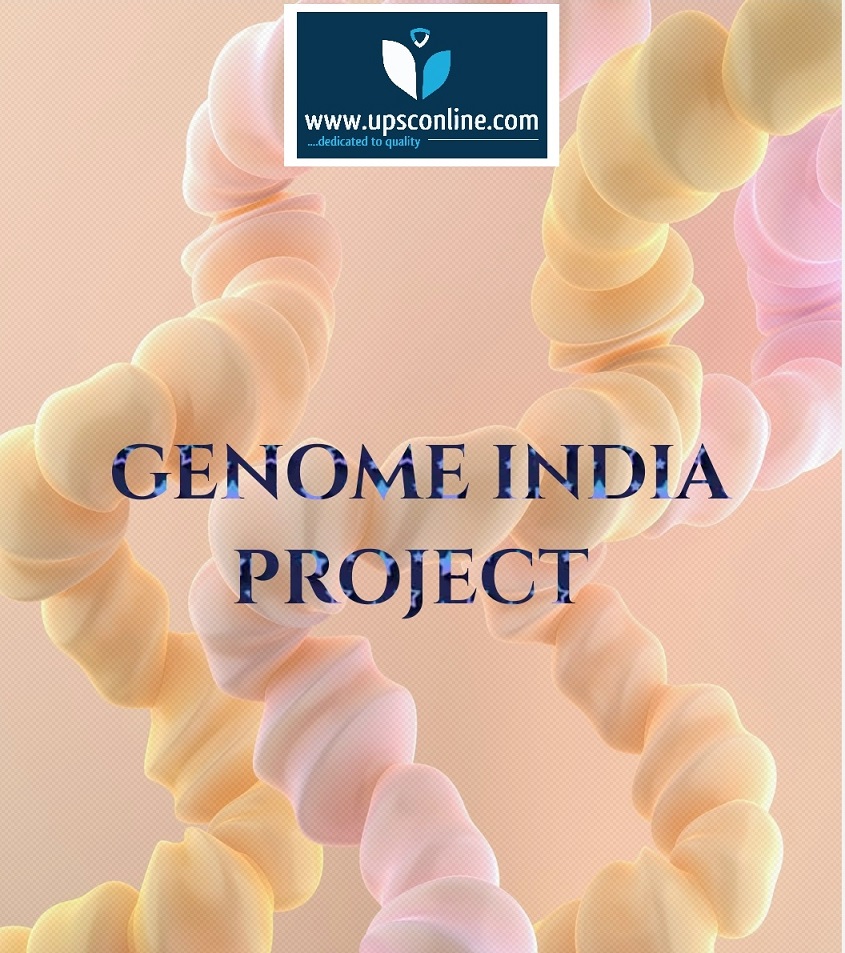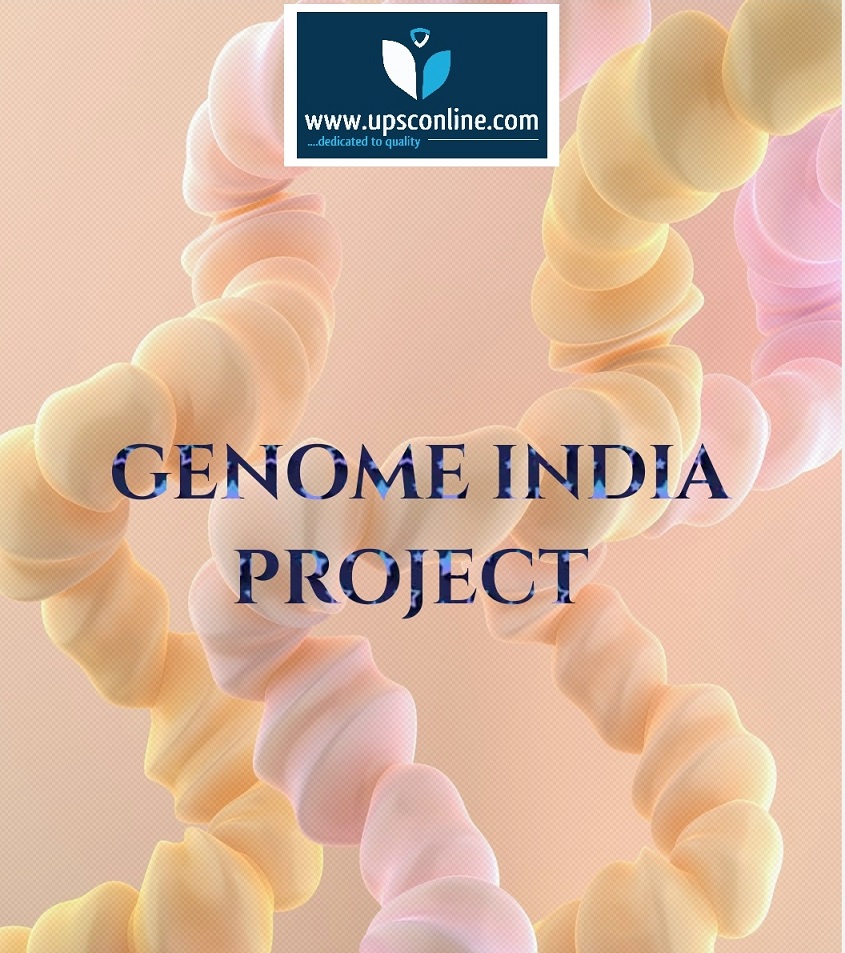
The Department of Biotechnology (DBT) has created the national resource data of whole genome sequencing of 10,074 healthy individuals from 83 heterogeneous populations from 99 different sites under the Genome India project to create a library of genetic variations.
The data has been archived at the Indian Biological Data Center (IBDC), a national repository set up by DBT. It will facilitate seamless access to valuable genetic information, enabling researchers to explore genetic variations and design more accurate genomic tools.
WHAT IS INDIA GENOME PROJECT?
It is a flagship project funded by the Department of Biotechnology, Ministry of Science and Technology.
It was launched in January 2020, with the objective to identify & catalogue the genetic variations of diverse Indian populations by sequencing the whole genome of 10,000 healthy individuals from 99 communities, representing all major linguistic & social groups, across the country.
The project is implemented with nationwide scientific collaboration and innovation involving 20 national institutes which included 4 sequencing centres; 13 sample collection centres; and 8 method development centres .
The principal objective of the project is to develop a reference genome for the population of India, which may lead to a better understanding of the nature of diseases and specific interventions essential for various ethnic groups. It may help in designing genome-wide and disease-specific genetic chips for low-cost diagnostics and research.
The project consortium completed the whole genome sequencing of 10,074 individuals in January 2024. The study has been ensured equitable sampling across linguistic, social, and regional groups in India.
Approximately, 36.7% of the samples were collected from rural, 32.2% from urban and 31.1% from the tribal populations.
The generated data can be used for developing indigenous chips, diagnostics and therapeutics, benefitting healthcare system of the country and thus will contribute to the bioeconomy of the country.
The DBT is aspiring to fund translational research in which this information set will serve as a template.
This data will be accessible for the researchers under the provisions of the Biotech-PRIDE (Promotion of Research and Innovation through Data Exchange) Guidelines and ‘Framework for Exchange of Data (FeED) Protocols.
It aims to construct a comprehensive catalogue of genetic variations, that will record our unique diversity. About 0.1 % of the entire sequence differs between any two individuals on average. These genetic variations are crucial for understanding our disease predispositions and rare inherited disorders. They may determine our response to drugs & help track migration and evolutionary patterns of population groups.
Genetic makeup & environmental influences of the population are closely associated. The risk factors for complex genetic diseases and rare genetic variations contributing to specific disorders are crucial in population-specific studies.
The Indian population of 1.3 billion consists of >4600 population groups, and several thousand of them are endogamous.
SIGNIFICANCE OF THE PROJECT
It is helpful in documenting the genetic structure of the nation’s population and create a database for researchers and doctors which is helpful in dealing with the genetic underpinnings of chronic diseases such as diabetes, hypertension, cardiovascular diseases, neurodegenerative disorders and cancer. It will also help in recognising mutations conferring risk of monogenic disorders.
The database generated from genome sequencing can fuel genetics research with greater precision, and to develop precision healthcare and diagnostics at affordable costs.
This digital database being outcome of representative public will may help democratise data, fostering large-scale human genetic studies and empowering nationwide research efforts.
Dr Mohd. Faruq, Scientist at CSIR-IGIB, explained, “This project provides a crucial baseline of population-specific genomic data, which helps in accurate diagnosis, risk prediction, and pharmacogenomics.
According to Dr Faruq , Many genetic variants influencing drug efficacy and adverse reactions are not found in international databases”.This highlights the need for a localised genomic reference to improve treatment outcomes and reduce adverse drug reactions.
One of the key promises of the Genome India Project is its potential to revolutionise healthcare through precision medicine. Dr Madhulika Kabra from AIIMS, New Delhi, stated, “Genome India offers a unique opportunity to identify population-specific genetic variants. This will help in targeted clinical interventions, such as identifying individuals at risk for genetic disorders and offering personalised treatment strategies.”
She also emphasised the project’s role in addressing rare diseases: “The availability of carrier frequency data for rare disorders will enable us to better define and manage these conditions in the Indian context.
The Genome India Project has uncovered over 135 million genetic variations, including 7 million novel variants not found in global databases. Many of these have clinical significance, such as predispositions to diseases like hypercholesterolemia and breast cancer.
Dr Arindam Maitra from BRIC-NIBMG, noted, “We’ve constructed polygenic risk scores (PRS) using this data, which will allow us to predict complex diseases more effectively. While genes cannot be modified, knowledge of genetic risks can help people make lifestyle changes to lower their risk.”
The absence of population-specific genomic data has often limited the success of genetic diagnostics in India. Dr Faruq remarked, “Commercial genetic diagnostic platforms often leave many cases undiagnosed due to the lack of Indian reference data. Genome India addresses this gap, improving diagnostic accuracy for monogenic and complex disorders.”
The Genome India Project, led by Y. Narahari of the Indian Institute of Science (IISc), Bangalore, and K. Thangaraj of the Centre for Cellular and Molecular Biology (CCMB), Hyderabad, involved 20 institutions such as IIT Jodhpur, IIT Delhi, IISER Pune, and Mizoram University.
Thangaraj, one of the joint directors of the Genome India Project, said in his presentation: “Genome sequencing gives you everything you need to know about genetic material.
The 99 populations may be classified into eight broad groups —Austro-Asiatic tribe, Continentally admixed, Dravidian tribe, Dravidian non-tribe, Indo-European non-tribe, Indo-European tribe, Tibeto-Burman non-tribe and Tibeto-Burman tribe.
It will further lead to cost-effective genetic tests, carrier screening applications for expectant couples, enabling efficient diagnosis of heritable cancers and pharmacogenetic tests to prevent adverse drug reactions are some of the other benefits of this initiative.
Genomic research raises several ethical considerations, particularly concerning privacy, consent, and data sharing. The Genome India Project emphasizes ethical guidelines and stringent data protection measures to ensure the privacy and confidentiality of participants’ genetic information.
Additionally, the project prioritizes obtaining informed consent from participants and fostering transparent communication about the research objectives and potential implications.
CHALLENGES IN THE PROJECT & RESEARCH
One of the primary challenges is the sheer scale and diversity of India’s population, encompassing numerous ethnicities, languages, and socio-cultural backgrounds. Ensuring adequate representation from all population groups while maintaining ethical standards and data quality poses a significant logistical challenge.
Moreover, genomic research requires substantial infrastructural and technological capabilities, including high-throughput sequencing platforms, computational resources for data analysis, and bioinformatics expertise.
Collaborative efforts between academia, industry, and government are essential to address these challenges and build robust genomic research infrastructure in India.
American Deputy Director of National Centre for Human Genomic Research (NCHGR), criticised that, the Human Genome Projects are mediocre science & a terrible science policy.
According to him Human are narcissistic species & the thought of their molecular blueprint might be exciting for most of them.
According to him this research is not arising from mass consensus . 95% of the DNA, does not code for protein and is thought by many junk .
CRITICISM
According to Goldstein & Brown in their seminal work on Cholesterol metabolism, mentioned that, they did not require the map position of Human Genomic Profile. Even during the discovery of genes responsible for cystic fibrosis & muscular dystrophy , did not require detailed sequence information.
Knowing the amino acid sequence of a mutant gene product does not ensure the development of rational therapies. The amino acid sequences & detailed X-ray structures of Rat Sarcoma (RAS) products have been known since several years.
Much of the work on the Human Genome Project was repetitive, the project interested and attracted more than just technicians. One of the most important legacies of the Human Genome Project is the role that interdisciplinary team science played in achieving the end goal.
The Human Genome Project brought together a diverse cohort of professionals from both the private and public sector. This included not only biologists, geneticists and medical professionals, but also computer engineers, bioethicists, legal experts, mathematicians, statisticians and many others.
“Big Science” is a term used, often pejoratively, to describe a large-scale, centralized scientific project usually funded by a government or large bureaucratic entity. This is in contrast to what can be called “small science,” or inquiry driven by individual investigators, which is done in smaller labs with a small staff led by a principal investigator.
Historically, “big science” projects were viewed by many scientists as wasteful and inefficient. They argued that the most fruitful scientific research required a more independent and focused approach driven by a hypothesis, or central question



0 Comments